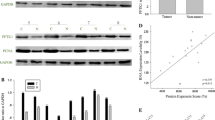Abstract
Skp2 is frequent amplified and overexpressed in breast cancer, making it a potential molecular target for cancer therapy. The objective of this study was to examine the effect of PPARγ overexpression on Skp2 expression in breast cancer cell lines. First, we investigated the role of PPARγ and Skp2 in human breast cancer progression. Immunohistochemical analysis of 70 specimens on formalin-fixed paraffin sections was performed. Furthermore in vitro, Western blot analysis was used to study the relationship between PPARγ and Skp2. We found that the expression of PPARγ and Skp2 expression was inverse correlation whether in vivo or in vitro. In addition, PPARγ overexpression can down-regulate the expression of Skp2 mRNA and protein in breast cancer cells. PPARγ overexpression decreased breast cancer cell proliferation and induced spontaneous apoptosis even in the absence of exogenous ligand. These PPARγ-overexpressing cells were dramatically more sensitive to PPARγ ligand-induced apoptosis compared with parental or Myc-control transfected cells. Overexpressing of Skp2 partially reversed PPARγ’s pro-apoptotic and anti-proliferative abilities. These results suggested that PPARγ’s pro-apoptotic and anti-proliferative abilities appear to be triggered at least in part by the modulation of Skp2.





Similar content being viewed by others
Abbreviations
- Skp2:
-
S-phase kinase-associated protein 2
- PPARγ:
-
Peroxisome proliferator-activated receptor γ
- Tro:
-
Troglitazone
References
Hortobagyi GN (1998) Treatment of breast cancer. N Engl J Med 339:974–984
Baselga J, Norton L (2002) Focus on breast cancer. Cancer Cell 1:319–322
Mangelsdorf DJ, Thummel C, Beato M et al (1995) The nuclear receptor superfamily: the second decade. Cell 83:835–839
Kliewer SA, Forman BM, Blumberg B et al (1994) Differential expression and activation of a family of murine peroxisome proliferator-activated receptors. Proc Natl Acad Sci USA 91:7355–7359
Schoonjans K, Staels B, Auwerx J (1996) The peroxisome proliferator activated receptors (PPARS) and their effects on lipid metabolism and adipocyte differentiation. Biochim Biophys Acta 1302:93–109
Willson TM, Brown PJ, Sternbach DD et al (2000) The PPARs: from orphan receptors to drug discovery. J Med Chem 43:527–550
Tontonoz P, Graves RA, Budavari AI et al (1994) Adipocyte-specific transcription factor ARF6 is a heterodimeric complex of two nuclear hormone receptors, PPAR gamma and RXR alpha. Nucleic Acids Res 22:5628–5634
Lehrke M, Lazar MA (2005) The many faces of PPARgamma. Cell 123:993–999
Yu HN, Lee YR, Noh EM et al (2008) Induction of G1 phase arrest and apoptosis in MDA-MB-231 breast cancer cells by troglitazone, a synthetic peroxisome proliferator-activated receptor gamma (PPARgamma) ligand. Cell Biol Int 32:906–912
Nakayama KI, Nakayama K (2006) Ubiquitin ligases: cell-cycle control and cancer. Nat Rev Cancer 6:369–381
Gstaiger M, Jordan R, Lim M (2001) Skp2 is oncogenic and overexpressed in human cancers. Proc Natl Acad Sci USA 98:5043–5048
Signoretti S, Di Marcotullio L, Richardson A et al (2002) Oncogenic role of the ubiquitin ligase subunit Skp2 in human breast cancer. J Clin Investig 110:633–641
Koga H, Harada M, Ohtsubo M et al (2003) Troglitazone induces p27Kip1-associated cell-cycle arrest through down-regulating Skp2 in human hepatoma cells. Hepatology 37:1086–1096
Allred DC, Harvey JM, Berardo M et al (1998) Prognostic and predictive factors in breast cancer by immunohistochemical analysis. Mod Pathol 11:155–168
Davidovich S, Ben-Izhak O, Shapira M et al (2008) Over-expression of Skp2 is associated with resistance to preoperative doxorubicin-based chemotherapy in primary breast cancer. Breast Cancer Res 10:R63
Ravaioli A, Monti F, Regan MM et al (2008) p27 and Skp2 immunoreactivity and its clinical significance with endocrine and chemo-endocrine treatments in node-negative early breast cancer. Ann Oncol 19:660–668
Jiang Y, Zou L, Zhang C et al (2009) PPARgamma and Wnt/beta-Catenin pathway in human breast cancer: expression pattern, molecular interaction and clinical/prognostic correlations. J Cancer Res Clin Oncol 135:1551–1559
Cohen GM (1997) Caspases: the executioners of apoptosis. Biochem J 326(Pt 1):1–16
Qin C, Morrow D, Stewart J et al (2004) A new class of peroxisome proliferator-activated receptor gamma (PPARgamma) agonists that inhibit growth of breast cancer cells: 1,1-Bis(3′-indolyl)-1-(p-substituted phenyl)methanes. Mol Cancer Ther 3:247–260
Koutnikova H, Auwerx J (2002) PPARgamma, an X-ceptor for Xs. Ann N Y Acad Sci 967:28–33
Lehmann JM, Moore LB, Smith-Oliver TA et al (1995) An antidiabetic thiazolidinedione is a high affinity ligand for peroxisome proliferator-activated receptor gamma (PPAR gamma). J Biol Chem 270:12953–12956
Mueller E, Sarraf P, Tontonoz P et al (1998) Terminal differentiation of human breast cancer through PPAR gamma. Mol Cell 1:465–470
Morrison RF, Farmer SR (1999) Role of PPARgamma in regulating a cascade expression of cyclin-dependent kinase inhibitors, p18(INK4c) and p21(Waf1/Cip1), during adipogenesis. J Biol Chem 274:17088–17097
Altiok S, Xu M, Spiegelman BM (1997) PPARgamma induces cell cycle withdrawal: inhibition of E2F/DP DNA-binding activity via down-regulation of PP2A. Genes Dev 11:1987–1998
Garcia-Bates TM, Bernstein SH, Phipps RP (2008) Peroxisome proliferator-activated receptor gamma overexpression suppresses growth and induces apoptosis in human multiple myeloma cells. Clin Cancer Res 14:6414–6425
Masuda TA, Inoue H, Sonoda H et al (2002) Clinical and biological significance of S-phase kinase-associated protein 2 (Skp2) gene expression in gastric carcinoma: modulation of malignant phenotype by Skp2 overexpression, possibly via p27 proteolysis. Cancer Res 62:3819–3825
Acknowledgments
This study was supported by grants from National Natural Science Foundation of China (No. 30300099, No. 30770488, and No. 30870320); Natural Science Foundation of Jiangsu province (No. BK2009156, No. BK2009157, No. BK2009161); Health Department of Jiangsu Province (H200760) and Key Subject of Jiangsu Province (xk20070320).
Author information
Authors and Affiliations
Corresponding authors
Additional information
Jie Meng and Yun Ding contributed equally to this work.
Electronic supplementary material
Below is the link to the electronic supplementary material.
11010_2010_570_MOESM1_ESM.tif
Information about the specificities of antibodies (×400). Immunostaining was performed using the PPARγ antibodies (a) or Skp2 antibodies (c) but not the secondary antibodies. On the other hand, Immunostaining was performed using normal rabbit IgG and the secondary antibodies (b, d). (TIFF 5709 kb)
Rights and permissions
About this article
Cite this article
Meng, J., Ding, Y., Shen, A. et al. Overexpression of PPARγ can down-regulate Skp2 expression in MDA-MB-231 breast tumor cells. Mol Cell Biochem 345, 171–180 (2010). https://doi.org/10.1007/s11010-010-0570-y
Received:
Accepted:
Published:
Issue Date:
DOI: https://doi.org/10.1007/s11010-010-0570-y




